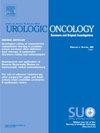HOSPITAL OUTCOMES AND HEALTHCARE BURDEN OF TESTICULAR CANCER: A RETROSPECTIVE ANALYSIS OF THE 2024 NATIONAL INPATIENT SAMPLE
IF 2.4
3区 医学
Q3 ONCOLOGY
Urologic Oncology-seminars and Original Investigations
Pub Date : 2025-03-01
DOI:10.1016/j.urolonc.2024.12.090
引用次数: 0
Abstract
Introduction
Testicular cancer, although relatively rare, is the most common malignancy in young men aged 15 to 35 years. It accounts for approximately 1% of all male cancers but has a high survival rate if detected early. Testicular cancer can have significant implications for fertility and quality of life, making it a critical area of focus for public health and clinical research. Despite advancements in treatment, disparities in outcomes exist based on various demographic and hospital-related factors. This study aims to estimate the prevalence, mortality rate, hospital length of stay (LOS), and total hospitalization charges for patients with testicular cancer using the National Inpatient Sample (NIS) data from 2021.
Methods
We conducted a retrospective analysis using the NIS dataset, which included 6,666,752 observations. Testicular cancer cases were identified using the appropriate ICD-10 code. Survey procedures (svy) were utilized to account for the complex survey design of the NIS. The primary outcome of interest was in-hospital mortality, while secondary outcomes included hospital length of stay (LOS) and total hospitalization charges (TOTCHG). Descriptive statistics and regression analyses were performed to examine the associations between testicular cancer and these outcomes. Independent variables included age, gender, race, zip code income quartile, Charlson Comorbidity Index, weekend admission, hospital region, teaching status, and bed size.
Results
The total number of testicular cancer cases was estimated to be 8,225 (95% CI: 7,434 - 9,016). The crude total of in-hospital deaths among testicular cancer patients was 265 (95% CI: 192 - 338), resulting in a mortality rate of 3.22% (95% CI: 2.45% - 4.23%). Adjusted logistic regression analysis revealed significant associations with the Charlson Comorbidity Index (Odds Ratio [OR] = 1.390, p < 0.001) and hospital teaching status (OR = 0.468, p = 0.043), while patients identified as Asian/Pacific Islander had a significantly higher odds ratio (OR = 6.210, p = 0.004).
The mean LOS for testicular cancer patients was 6.44 days (95% CI: 6.07 - 6.82). Adjusted linear regression analysis showed that LOS was significantly associated with patients identified as Native American (Coefficient = 14.039, p = 0.041) and Charlson Comorbidity Index (Coefficient = 0.590, p < 0.001). The mean total hospitalization charges for testicular cancer patients were $88,194 (95% CI: $80,853 - $95,536). Adjusted regression analysis identified significant associations with Charlson Comorbidity Index (Coefficient = $8,633, p < 0.001), hospital region, teaching status (Coefficient = $19,921, p = 0.006), and hospital bed size (Coefficient for the largest bed size category = $19,562, p = 0.009).
Conclusions
This study highlights the significant burden of testicular cancer in hospitalized patients, with notable associations between mortality, length of stay, and hospitalization charges with various demographic and hospital-related factors. Higher Charlson Comorbidity Index and specific racial categories were linked to higher mortality rates, while higher Charlson Comorbidity Index and specific racial categories were associated with longer hospital stays. Total hospitalization charges were influenced by comorbidity index, hospital region, teaching status, and bed size. These findings underscore the need for targeted healthcare strategies to improve outcomes for testicular cancer patients, taking into account the identified demographic and hospital-related factors.
睾丸癌的住院结果和医疗负担:对2024年全国住院患者样本的回顾性分析
睾丸癌虽然相对罕见,但却是15至35岁年轻男性中最常见的恶性肿瘤。它约占所有男性癌症的1%,但如果及早发现,生存率很高。睾丸癌可能对生育能力和生活质量产生重大影响,使其成为公共卫生和临床研究的重点领域。尽管在治疗方面取得了进步,但由于各种人口和医院相关因素,结果存在差异。本研究旨在利用2021年以来的全国住院患者样本(NIS)数据,估计睾丸癌患者的患病率、死亡率、住院时间(LOS)和总住院费用。方法使用NIS数据集进行回顾性分析,该数据集包括6,666,752个观测值。使用适当的ICD-10代码确定睾丸癌病例。调查程序(svy)被用来解释NIS复杂的调查设计。主要结局是住院死亡率,次要结局包括住院时间(LOS)和总住院费用(TOTCHG)。采用描述性统计和回归分析来检验睾丸癌与这些结果之间的关系。自变量包括年龄、性别、种族、邮政编码收入四分位数、Charlson合并症指数、周末入院率、医院区域、教学状况和床位大小。结果睾丸癌病例总数估计为8,225例(95% CI: 7,434 ~ 9,016)。睾丸癌患者住院死亡的粗略总数为265人(95% CI: 192 - 338),死亡率为3.22% (95% CI: 2.45% - 4.23%)。校正logistic回归分析显示与Charlson合并症指数有显著相关性(比值比[OR] = 1.390,p <;0.001)和医院教学状况(OR = 0.468,p = 0.043),而亚洲/太平洋岛民患者的优势比显著高于(OR = 6.210,p = 0.004)。睾丸癌患者的平均生存时间为6.44天(95% CI: 6.07 - 6.82)。校正线性回归分析显示,LOS与印第安人(系数 = 14.039,p = 0.041)和Charlson合并症指数(系数 = 0.590,p <;0.001)。睾丸癌患者的平均总住院费用为88,194美元(95% CI: 80,853 - 95,536美元)。校正回归分析发现与Charlson共病指数有显著相关性(系数 = $8,633,p <;0.001)、医院区域、教学状况(系数 = $19,921,p = 0.006)和医院床位大小(最大床位类别的系数 = $19,562,p = 0.009)。结论睾丸癌在住院患者中的负担显著,死亡率、住院时间和住院费用与各种人口统计学和医院相关因素之间存在显著关联。较高的Charlson共病指数和特定的种族类别与较高的死亡率有关,而较高的Charlson共病指数和特定的种族类别与较长的住院时间有关。住院总费用受合并症指数、医院区域、教学状况和床位大小的影响。这些发现强调需要有针对性的医疗保健策略来改善睾丸癌患者的预后,同时考虑到已确定的人口统计学和医院相关因素。
本文章由计算机程序翻译,如有差异,请以英文原文为准。
求助全文
约1分钟内获得全文
求助全文
来源期刊
CiteScore
4.80
自引率
3.70%
发文量
297
审稿时长
7.6 weeks
期刊介绍:
Urologic Oncology: Seminars and Original Investigations is the official journal of the Society of Urologic Oncology. The journal publishes practical, timely, and relevant clinical and basic science research articles which address any aspect of urologic oncology. Each issue comprises original research, news and topics, survey articles providing short commentaries on other important articles in the urologic oncology literature, and reviews including an in-depth Seminar examining a specific clinical dilemma. The journal periodically publishes supplement issues devoted to areas of current interest to the urologic oncology community. Articles published are of interest to researchers and the clinicians involved in the practice of urologic oncology including urologists, oncologists, and radiologists.

 求助内容:
求助内容: 应助结果提醒方式:
应助结果提醒方式:


